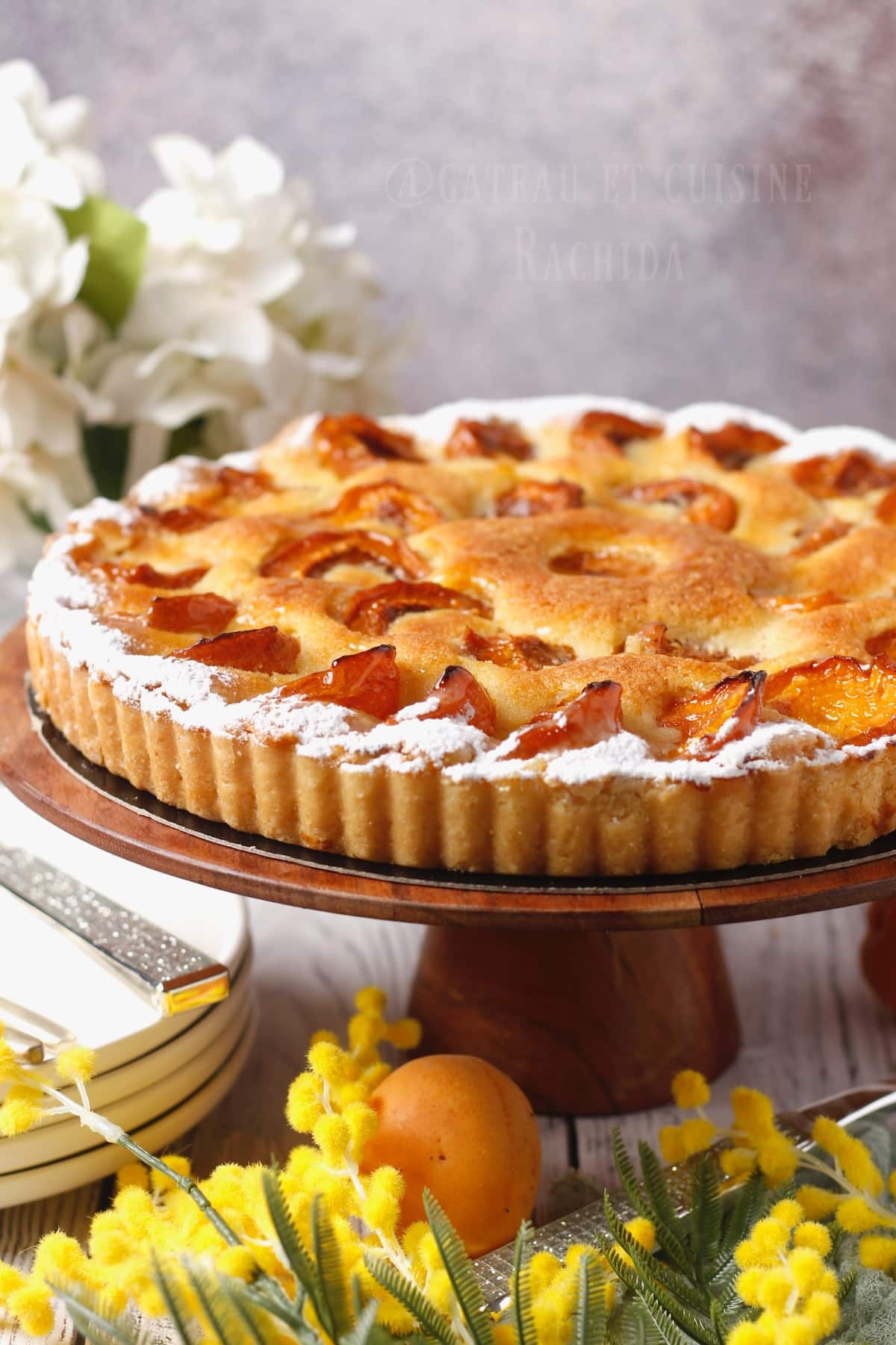
A delicious apricot tart, simple and easy to make, with a buttery shortbread crust.
A gourmet dessert that brings out the fragrance of sun-drenched apricots. Slightly tangy, they turn into a true delicacy when cooked, offering a perfect balance between sweetness and acidity. When baked, they gently brown and develop a slight caramelization, creating a melt-in-your-mouth texture and delicious flavor.
Sometimes sprinkled with sliced almonds before baking, this apricot almond tart offers an extra touch of indulgence with a pleasant crunch under the tooth. Perfect as a dessert to finish a meal or as a snack. You can make it all year round, using apricots in syrup or frozen.
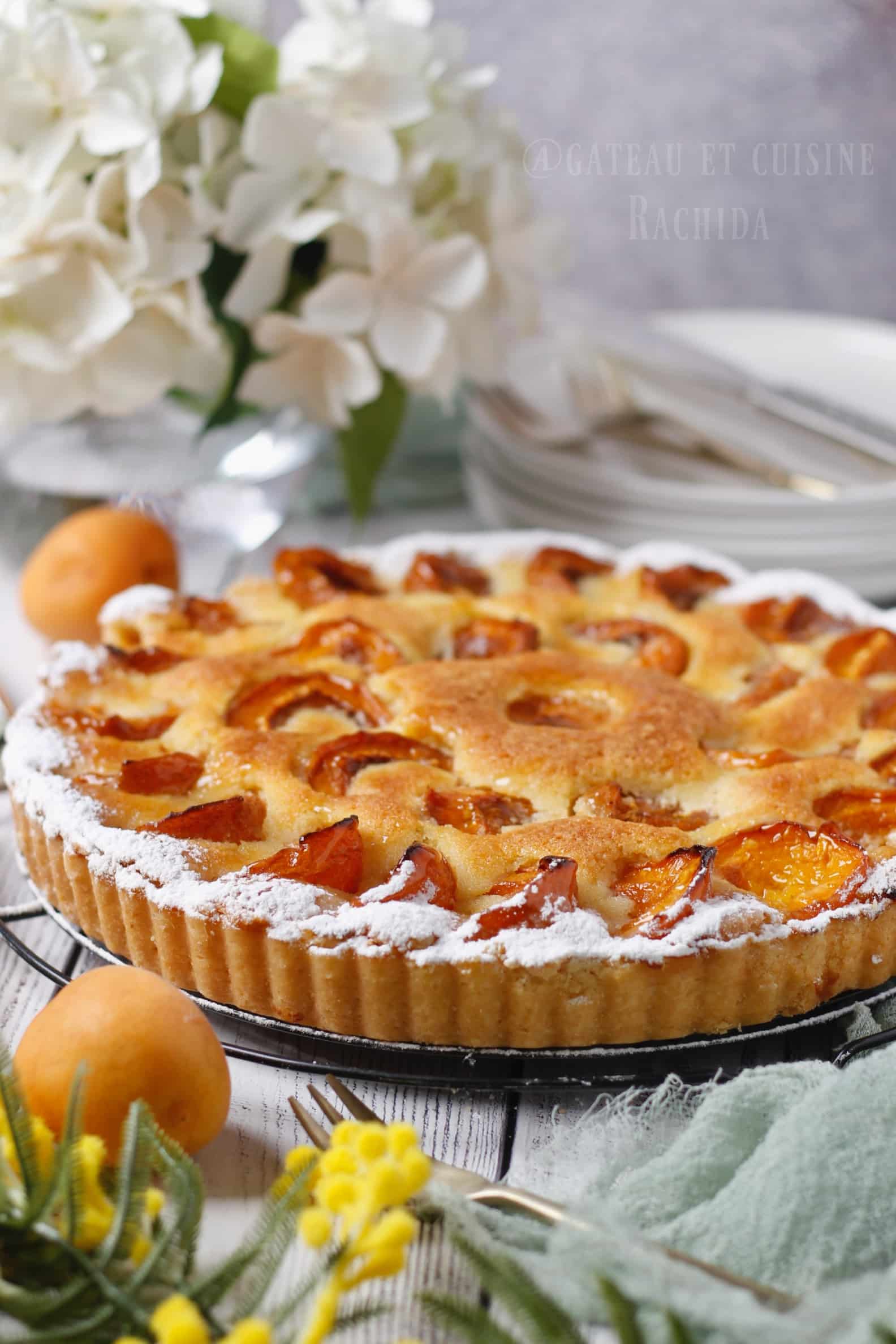
Table of Contents
What you’ll love about this apricot tart
Difficulty level: It’s easy and doesn’t require a lot of preparation. It’s ideal for beginners, but requires a little care to prepare the shortcrust pastry and arrange the apricots harmoniously.
Success depends above all on the quality of the fruit and the way the shortcrust pastry is cooked. The apricot tart is part of the French pastry training program.
Can be made all year round: This is a tart that can be made in any season. In summer to enjoy fresh apricots, and the rest of the year with apricot halves in syrup or frozen.
Texture: The crumbly shortcrust pastry, combined with the melting almond cream and the slightly tangy apricot flavor, offers a delightful blend of textures and flavors.
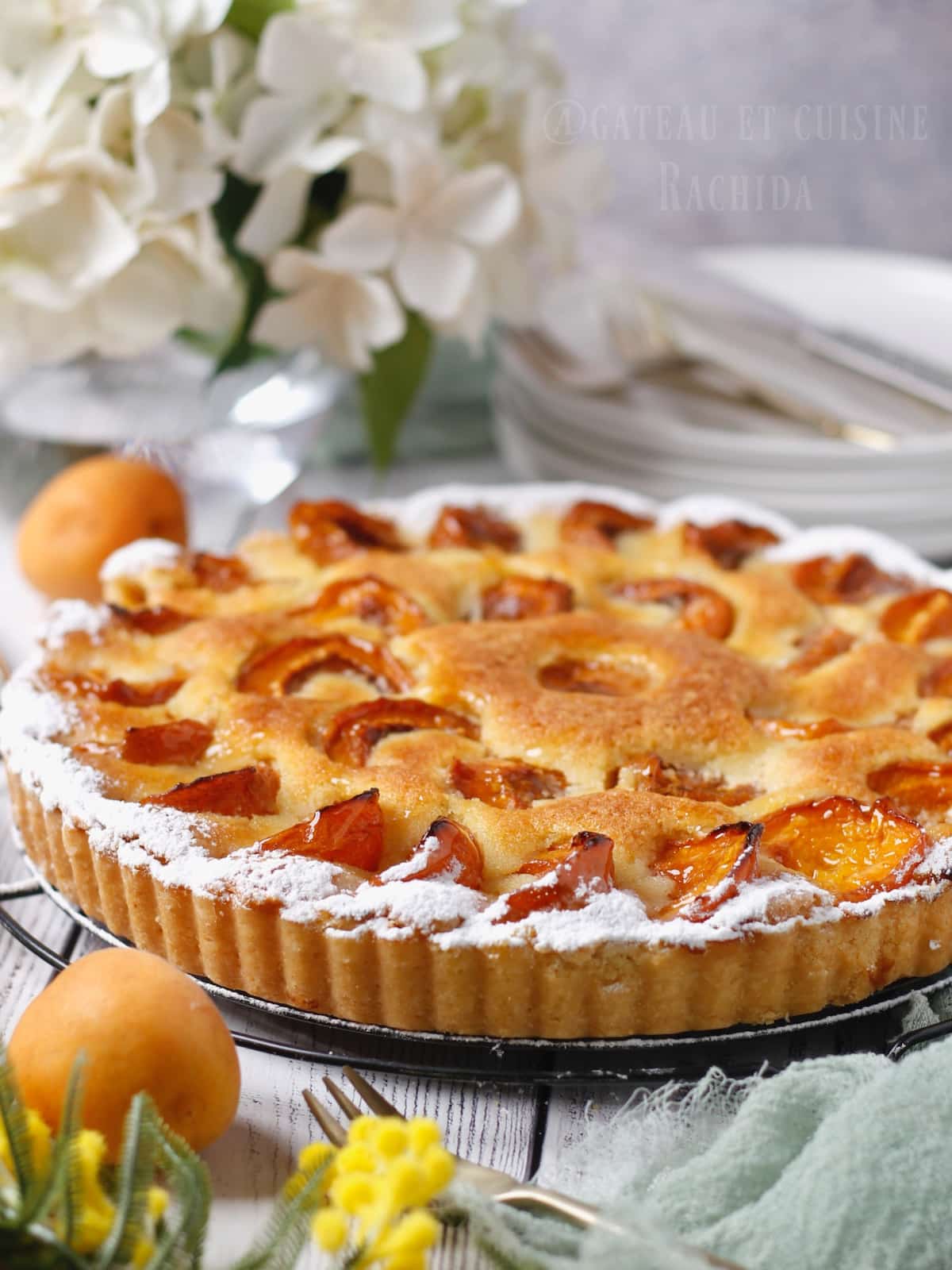
Variation and substitution
Shortcrust pastry: If you prefer, you can replace the shortcrust pastry with puff pastry, store-bought or homemade pastry crust, or sweet pastry, depending on your preferences and the texture you’re looking for.
If you don’t have any, you don’t need to use almond powder in the shortcrust pastry.
Apricots: When in season, use fresh, ripe, firm apricots. For the rest of the year, apricot halves in syrup or frozen will do just fine. You can also use other seasonal fruits. The basis will remain the same.
Almond flour: This tart is delicious with an almond cream made from white almond powder. You can, however, replace it with raw, roasted and ground almond powder for a more intense almond flavor.
You can also add a few drops of bitter almond extract, to taste.
Apricots also go very well with pistachio. You can replace all the almonds with fine pistachio powder, and add a generous spoonful of pistachio paste for even more flavor, but this is optional.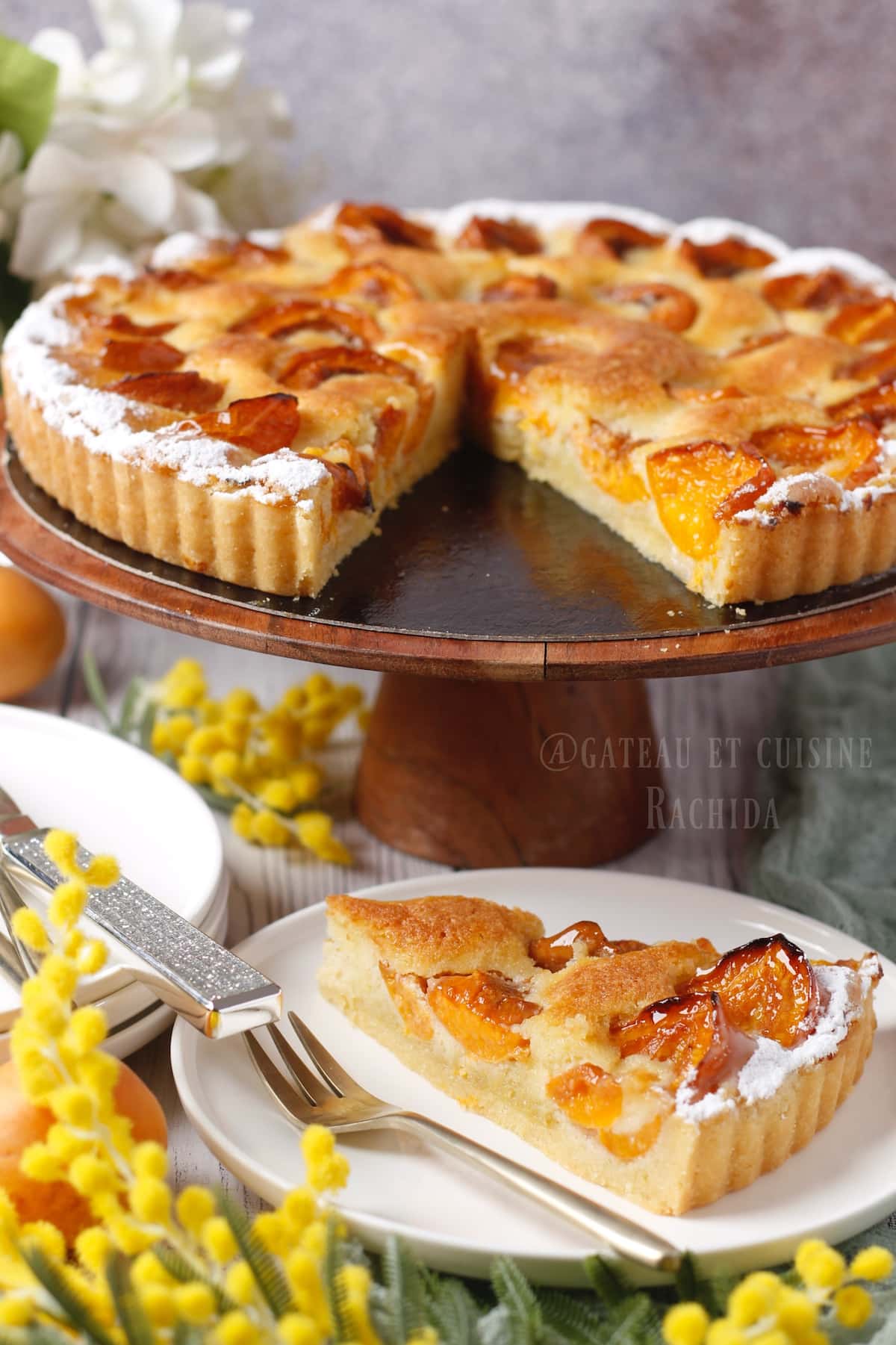
Tips for a successful apricot tart
Generally, you can either line the tart pan, then fill it with cream and apricots before baking, or pre-bake the tart crust before adding the filling.
When using juicy fruits, I prefer to opt for blind baking the crust for about fifteen minutes, or until the tart base is lightly golden. I then let it cool before adding the filling.
If you follow the instructions in the shortcrust pastry recipe correctly, you won’t need to prick the pastry or use baking beads. The shortcrust pastry won’t collapse, the tart base won’t puff up, and the result will be perfect.
You can bake the tart crust a bit longer than shown in the image below.
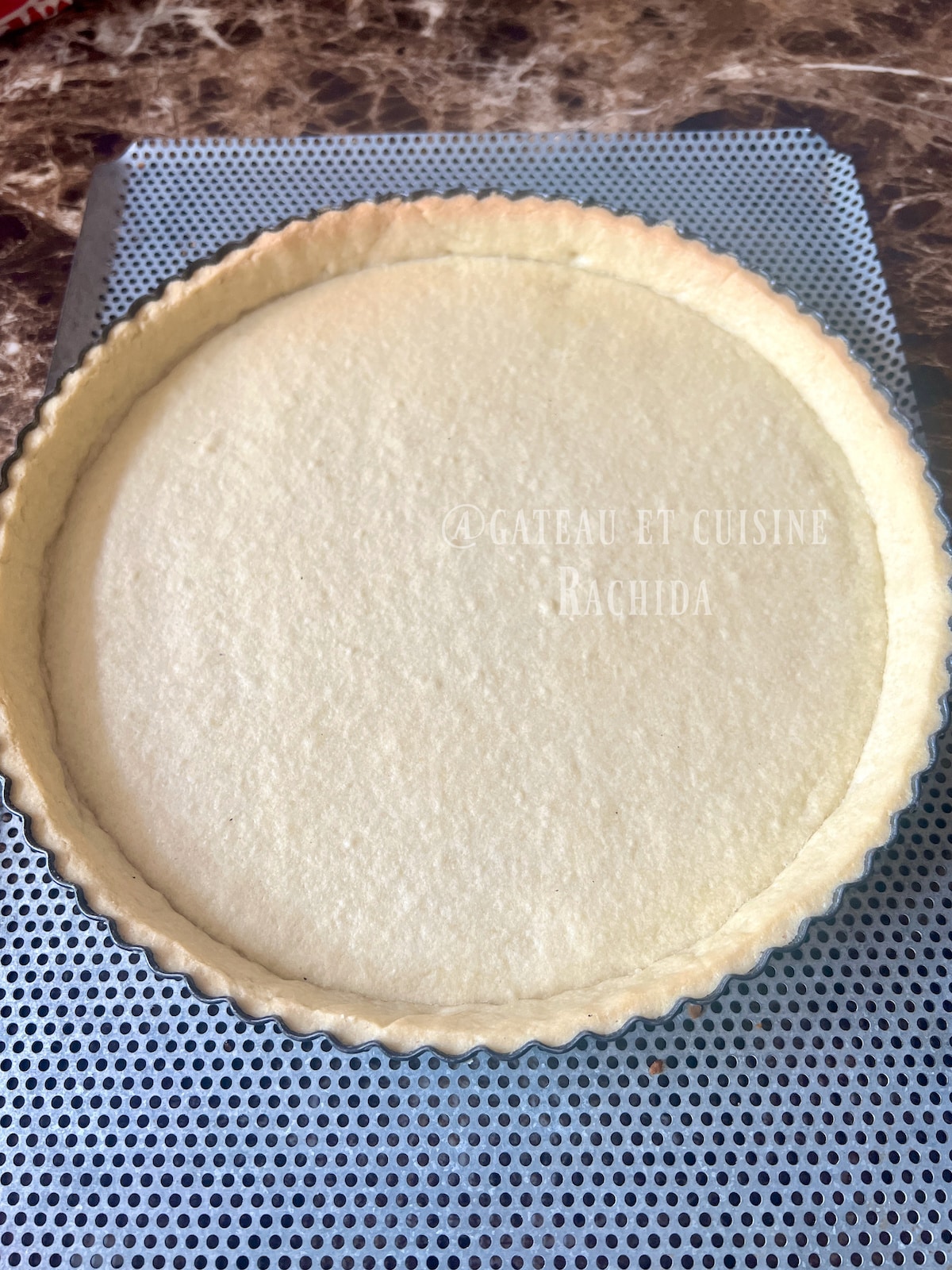
Preparation steps :
NB: For full details of ingredients, see the recipe card at the end of this article, which you can print out. Below are the instructions, which you can also view in images.
I used a 28 cm by 3 cm perforated tart mold (11 inches by 1.2 inches). I will also provide the quantities for a 22 cm by 2 cm tart ring (8.7 inches by 0.8 inches).
Shortbread pastry :
1. In the bowl of a stand mixer or a large mixing bowl, combine the flour, powdered sugar, almond powder, salt, and optionally the seeds from a vanilla pod.
2. Add the cold, but not hard, butter cubes and mix with the paddle attachment of the stand mixer or using your fingers until the mixture resembles coarse sand.
3. Add the beaten egg and mix briefly to bring everything together. Don’t work until the dough forms a ball, just a homogeneous dough.
4. Turn the dough out onto a work surface and press it forward with the palm of your hand 2 to 3 times to help incorporate the ingredients, then gather it into a ball.
5. Wrap the dough in cling film, flattening it slightly. It will cool faster and be easier to spread.
6. Leave to rest in the refrigerator for about 2 h or prepare the day before.
Note: This resting time will prevent the dough from collapsing in the tart pan during baking. It will also be easier to spread and handle.
7. After this resting time, roll out the dough between two sheets of parchment paper to a thickness of 2 to 3 mm (0.08 to 0.12 inches). If the dough is too cold, let it relax for 5 minutes. If it’s hot, put it back in the fridge for 20 minutes, or until it’s firmer and easier to handle.
8. Line the buttered tart pan, placed on a perforated baking sheet (preferably), with a Silpain mat or parchment paper.
9. Remove excess dough with a rolling pin. Using a piece of parchment paper, smooth the bottom and sides, pressing the dough down to form a right angle.
10. Finish by trimming the edges with a knife.
11. Freeze the tart crust for 30 minutes before baking it for blind baking.
12. If you are not using very juicy fruits, you can fill it immediately and bake in a single step.
13. Preheat the oven to 160°C (320°F) with the fan on and bake the tart crust for about fifteen minutes, or until the dough is lightly golden.
14. Remove from oven and allow to cool. Meanwhile, prepare the almond cream.
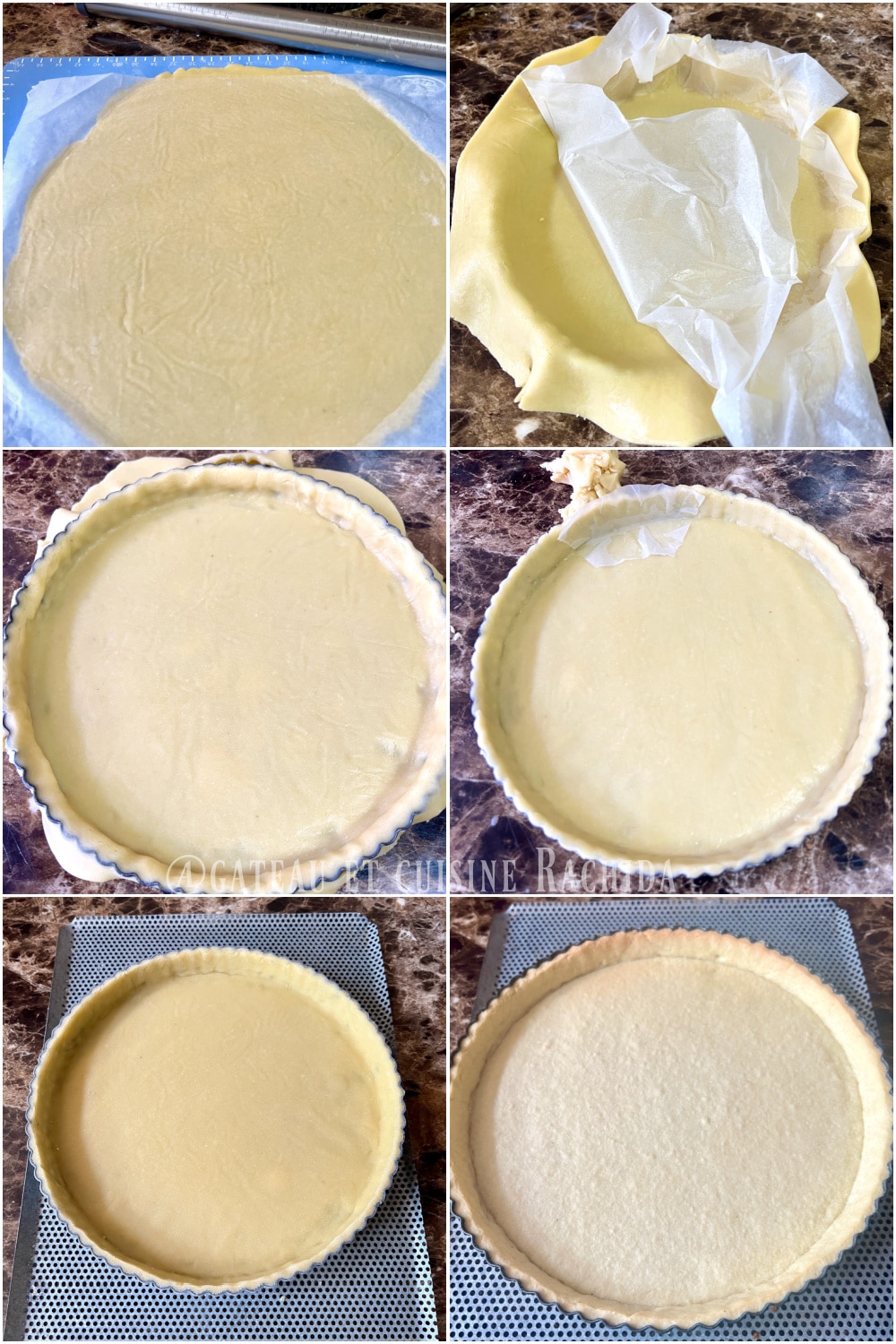
Almond cream:
1. In a bowl, cream the softened butter and sugar using a rubber spatula.
2. Add the almond flour in three parts, alternating with the beaten eggs.
3. Mix between each addition to incorporate the egg without whipping, until you achieve a smooth, homogeneous cream.
4. Cover with plastic wrap and refrigerate while the tart shell cools.
Cooking and garnishing
3. Preheat the oven to 175°C (350°F) on conventional (static) mode.
3. Spread the almond cream over the cooled tart shell up to three-quarters full, to prevent the cream from overflowing.
4. Cut the apricots in half and arrange them in a circle on the cream, cut side up, tilting them slightly backward (see image below).
5. Sprinkle with sliced almonds.
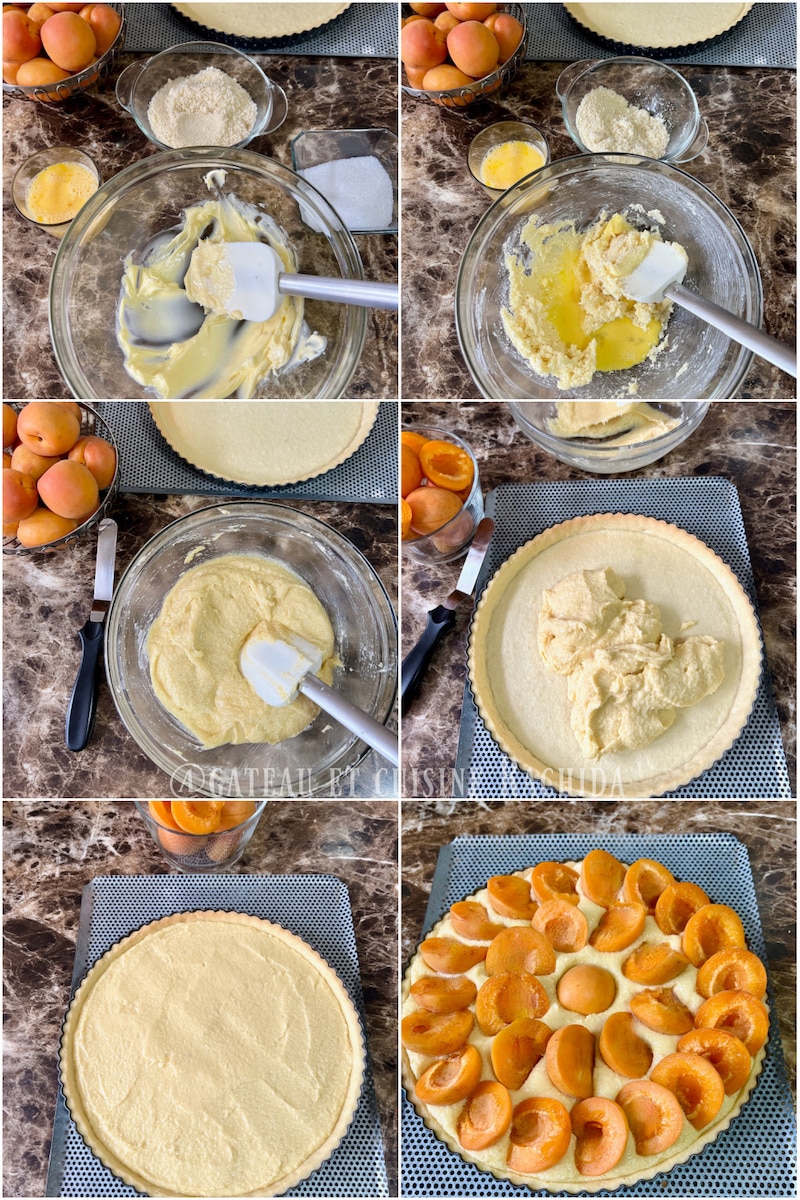 6. Place the tart in the oven for around 40 minutes, depending on the oven, until the tart is golden brown and the almond cream is cooked.
6. Place the tart in the oven for around 40 minutes, depending on the oven, until the tart is golden brown and the almond cream is cooked.
Note: If the top browns before the tart is fully baked, cover it with a sheet of aluminum foil.
7. Check the almond cream’s doneness with a skewer; it should come out clean when inserted into the center of the tart.
8. Place the tart on a wire rack and let it cool before removing it from the ring.
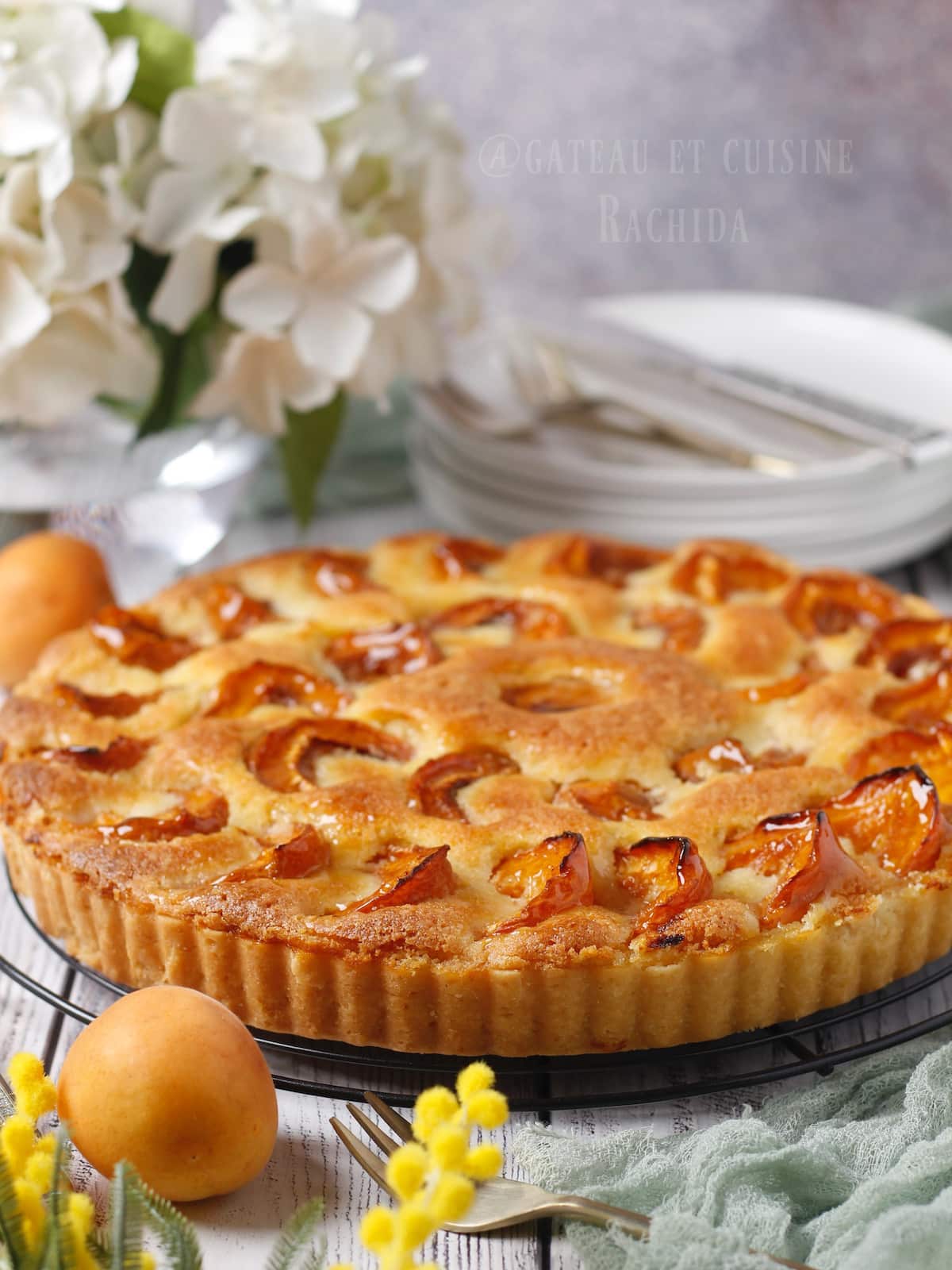
Finishing touch :
1. Lightly heat the neutral glaze or apricot jelly to liquefy it.
2. Brush over apricots.
3. Dust the entire tart with powdered sugar or just the edges before serving. To sprinkle only around the edge, hold a plate or golden presentation board over the tart, without touching it, to protect the center.
4. Serve warm or at room temperature.
5. You can keep it in the refrigerator until it’s time to serve.
Other pie recipes
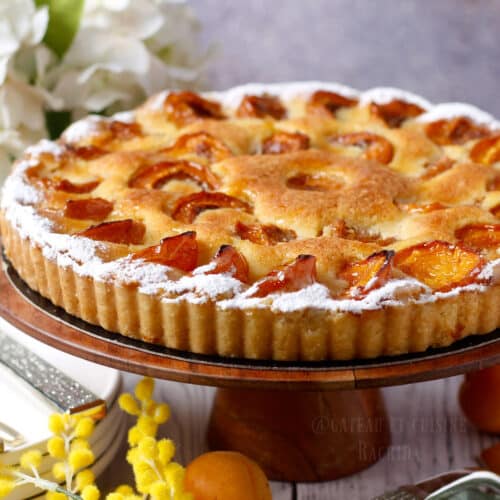
Recette Tarte aux abricots
EQUIPEMENTS
INGREDIENTS
Pour un moule à tarte de 28 cm sur 3.
Pour la pâte sablée :
- 250 g farine de préférence T55
- 130 g beurre froid mais pas dur coupé en dés le sortir une dizaine de minutes du réfrigérateur
- 100 g sucre glace
- 30 g poudre d’amande optionnel
- 1/3 cuillère à café de sel (1 g)
- 1 gros œuf (60 g )à adapter selon l’absorption de la farine
- 1 gousse de vanille optionnel
Pour la crème d'amande :
- 140 g poudre d’amandes
- 140 g beurre mou
- 140 g sucre
- 140 d’œufs battus
Pour la garniture :
- Une quinzaine d’abricots frais ou des oreillons d’abricots au sirop ou surgelés
- Amandes effilées pour la décoration optionnel
Pour la finition :
- Nappage neutre ou gelée d'abricots chauffée
Pour un cercle à tarte de 22 cm sur 2
Pour la pâte sablée :
- 200 g farine de préférence T55
- 100 g beurre froid mais pas dur coupé en dés le sortir une dizaine de minutes du réfrigérateur
- 80 g sucre glace
- 25 g poudre d’amande optionnel
- 1/4 cuillère à café sel
- 1 œuf (50 g )à adapter selon l’absorption de la farine
- 1/2 gousse de vanille optionnel
Pour la crème d'amande :
- 70 g poudre d’amandes
- 70 g beurre mou
- 70 g sucre
- 70 d’œufs battus
Pour la garniture :
- Une douzaine d’abricots frais ou des oreillons d’abricots au sirop ou surgelés
- Amandes effilées pour la décoration optionnel
Pour la finition :
- Nappage neutre ou gelée d'abricots chauffée
PREPARATION
- J'ai utilisé un moule à tarte perforée de 28 cm sur 3.
La pâte sablée :
- Dans le bol du robot ou dans un saladier, mélangez la farine, le sucre glace, la poudre d’amande, le sel et éventuellement les grains d'une gousse de vanille.
- Ajoutez les dés de beurre froid mais pas dur et sablez au robot muni de la feuille ou du bout des doigts jusqu’à obtenir une texture de sable.
- Incorporez l’œuf battu et mélangez brièvement pour rassembler le tout. Ne travaillez pas jusqu’à la formation d’une boule de pâte mais juste jusqu'à la formation d’une pâte homogène.
- Renversez la pâte sur le plan de travail et la fraser avec la paume de la main 2 à 3 fois puis la rassembler en boule.
- Enveloppez la pâte dans du film alimentaire en l’aplatissant un peu. Elle refroidira ainsi plus vite et sera plus simple à étaler.
- Laissez-la reposer au réfrigérateur pendant environ 2 h ou de préférence la préparer la veille.
- Note : Ce temps de repos empêchera la pâte de s’affaisser. Elle sera également plus facile à étaler et à manipuler.
- Après ce temps de repos, étalez la pâte entre deux feuilles de papier sulfurisé sur une épaisseur de 2 à 3 mm. Si la pâte est trop froide, laissez-la se détendre pendant 5 minutes. S'il fait chaud, remettez-la au réfrigérateur pendant 20 minutes ou jusqu’à ce qu'elle soit plus ferme et plus facile à manipuler.
- Foncez le moule à tarte beurré posé sur une plaque perforée (de préférence) couverte d'une toile silpain ou de papier sulfurisé.
- Retirez l'excédent de pâte avec le rouleau à pâtisserie. À l’aide d’un morceau de papier sulfurisé, lissez le fond et les côtés en pressant bien la pâte pour former un angle droit.
- Finalisez en parant les bords à l'aide d'un couteau.
- Bloquer le fond de tarte 30 minutes au congélateur avant de l'enfourner pour une cuisson à blanc.
- Si vous n’utilisez pas de fruits très juteux, vous pouvez garnir immédiatement et faire une seule cuisson.
- Préchauffez le four à 160°C en chaleur ventilée et enfournez le fond de tarte pendant une quinzaine de minutes ou jusqu’à ce que la pâte soit légèrement dorée.
- Sortir du four et laissez refroidir.
- Pendant ce temps, préparez la crème d’amande.
La crème d’amande :
- Dans un bol, crémer le beurre mou et le sucre à l’aide d’une Maryse.
- Ajoutez la poudre d’amande en 3 fois en alternant avec les oeufs battus.
- Mélanger entre chaque ajout pour incorporer l’oeuf sans fouetter, jusqu’à obtenir une crème homogène.
- Filmez et laissez-la au réfrigérateur le temps que le fond de tarte refroidisse.
Cuisson et garniture
- Préchauffer le four à 175°C en fonction Statique (normal)
- Étalez la crème d’amande sur le fond de tarte froid jusqu'au 3/4 sinon la crème risque de déborder.
- Coupez les abricots en deux et disposez-les en couronne sur la crème, côté coupé vers le haut en les penchant légèrement vers l'arrière(voir image ci-dessous)
- Vous pouvez saupoudrer d'amandes effilées.
- Enfournez la tarte pendant environ 40 minutes plus ou moins selon les fours, jusqu’à ce que la tarte soit bien dorée et la crème d'amande cuite.
- Note : Si le dessus dore avant que la tarte ne soit cuite, couvrir d'une feuille de papier aluminium.
- Vérifiez la cuisson de la crème d'amande avec un pic à brochette qui, inséré au cœur de la tarte, doit ressortir sec.
- Déposer la tarte sur une grille et la laisser refroidir avant de la décercler.
Finition :
- Chauffer légèrement le nappage neutre ou la gelée d'abricot pour les liquéfier.
- Napper les abricots à l'aide d'un pinceau.
- Saupoudrez entièrement de sucre glace ou seulement les bords avant de servir. Pour saupoudrer uniquement la bordure, tenez une assiette ou un carton doré de présentation au-dessus de la tarte, sans qu'il ne la touche, afin de protéger le centre.
- Servez tiède ou à température ambiante.
- Vous pouvez la réserver au réfrigérateur jusqu'au moment de la dégustation.
Thank you for visiting my blog and for your comments.
You can also follow me on my youtube channel
